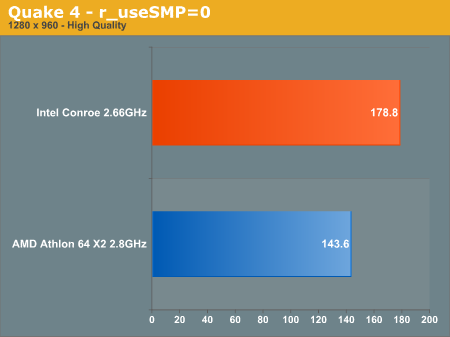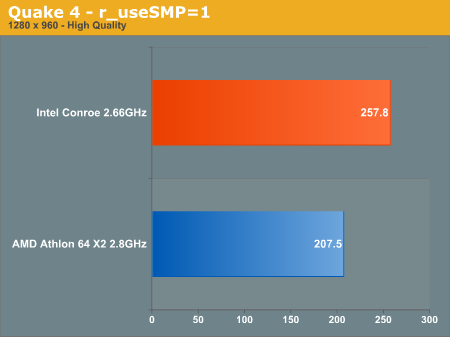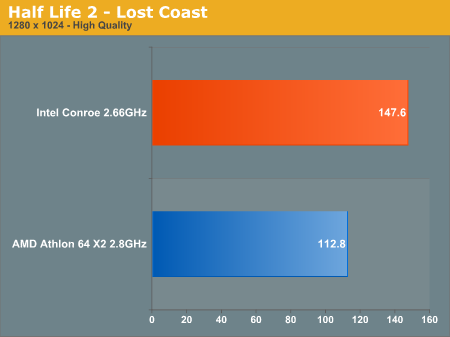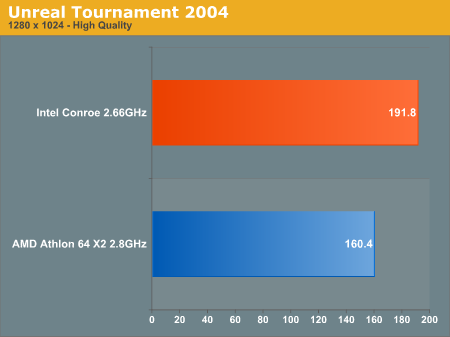Spring IDF 2006 Conroe Preview: Intel Regains the Performance Crown
by Anand Lal Shimpi on March 7, 2006 3:58 PM EST- Posted in
- Trade Shows
Gaming Performance
The one area where AMD has been the clear leader for years has been in gaming performance - Conroe changes everything.
Updated: In Don MacDonald's keynote he also provided us with another reference point for Conroe's performance, this time under Call of Duty 2. We have no idea what settings they ran at but the results we saw were Conroe at 111 fps and a Pentium Extreme Edition 3.73GHz scoring 90 fps. But the most interesting gaming tests are below:
First off we've got Quake 4 running the 1.0.5.0 patch at 1280 x 1024 with High Quality settings. The only demo available was Intel's own demo but nothing looked out of the ordinary with the recording. We tested with both r_useSMP enabled and disabled, first the SMP disabled numbers. Updated: The Quake 4 scores have been updated as mentioned in our follow-up article.

With SMP disabled, Conroe holds a 25% performance advantage over the 2.8GHz Athlon 64 X2. Enabling SMP provides a similar 24% performance advantage.

Next up is a Half Life 2 Lost Coast demo, once more an Intel supplied demo but there's only so much you can do to a demo recording to make it favor one CPU maker over another:

Conroe's performance advantage extends to 31% under Half Life 2, talk about a complete role reversal here.

We finish off this page with Unreal Tournament 2004 and a 20% performance advantage for Conroe.










220 Comments
View All Comments
Aelius - Wednesday, March 8, 2006 - link
It's nice to see Intel trying to take the lead but this proves no evidence of them being on the top.Here are a few things I look for in a system and I'm sure others, with experience building system, will agree too.
1. Price: If it costs $2000 for an AMD system or $3000 for a similar performance Intel system then you know what I will pick. Bottom line is we don't know price till it hits the streets as availability and other factors will impact it and I never take any price points as gospel from AMD or Intel as stores (retail and online) set the standards. Paper says $300 store says $350 etc. Talk is cheap.
2. Stability: Unless a stable system exists I won't touch it with a 10 foot pole. I have been burned on both ends by both AMD (most recently due to poor motherboard offerings until just recently under socket 939) and Intel (due to faulty CPUs and re-branding of CPUs under a new name with a few tweaks and sold as new, see class action lawsuits) systems. My next $2000 system is not going into new tech but established proven tech where I won't have to fight for a year and a half to get it to work right or replace half the system to make it so nor worry that I got hoodwinked by a shady company capitalizing on its own brand name.
3. Bottleneck: Anyone with some knowledge knows that CPU is not the bottleneck in high end systems and nobody in their right mind spends a couple of grand on a mid-high level system to run it at resolutions that you haven't used since the late 90s. Show me scores based on resolutions used in 20" or higher LCDs including widescreens and then I'll bite. So the jury is out for a few months until that happens.
4. Ethics: I find it very difficult to even think of buying Intel simply because of the company ethics regarding employees and general behaviour (much like any other major corporation) so I'm happy that at least I have an option.
You won't find performance on my list because its so subjective and because I think it belongs under Stability. It won't matter if you have a horse that can run laps around all others if it decides to stop to smell the roses whenever it damn feels like it.
So 3 cheers for competition but I'm biting down with a huge grain of salt and most likely won't wait a year to make sure the system is established before I upgrade as that will happen within 6 months for me. Perfect time to get a top end socket 939 system before it's phased out and instead invest the savings into the real Bottleneck found at the mid-high end where I and so many others play. Video cards...
PeteRoy - Wednesday, March 8, 2006 - link
AMD fanbois I have one thing to say to you: EAT IT AND LIKE ITsp1nfer - Wednesday, March 8, 2006 - link
Possible Intel fanboy: Go wash, brush your teeth, make your bed, have breakfast and go out. There's 6, SIX months ahead, you can predict none. Nice try, who's the fanboy now?saiyan - Wednesday, March 8, 2006 - link
After all, performance per dollar is what everyone should be looking at.If Conroes will be priced at around or lower than the comparable AMD processor, I might get one. But then AMD may decide to lower prices on its chips.
Hmmm.. Competition is good.
fikimiki - Wednesday, March 8, 2006 - link
1. If you just compare UT 2004 anand benchmark test for Athlon64 3800+ X2, you will notice that on similar configuration with UT 2004 they can achieve 56 fps 1024x768.And Intel on IDF can get 160 (1280x960) on FX machine!!!??
Do the same comparision to real Anand tests and what was tested on IDF.
If you belive Intel, you just belive that FX60 2.8GHz is 100% faster than Athlon64 X2 2GHz...
IntelUser2000 - Wednesday, March 8, 2006 - link
Yea yea yea, another skeptic. You might realize Crossfire X1900XT is more powerful than single X850XT PLUS the A64 3800+ may use Botmatch while IDF system may use Flyby. A big difference.
JackPack - Wednesday, March 8, 2006 - link
There's about a 0% chance that the timedemos used are identical. You can't draw any conclusion.xenon74 - Wednesday, March 8, 2006 - link
Buckle your seatbelt Dorothy 'cause Kansas is going bye bye!x74
mkone - Wednesday, March 8, 2006 - link
What size file was used in the iTunes test. In one test, a 304MB file tooks 32s to encode on an Athlon FX60, and here, we have 73s, so this file should be at least approximately 696MB. Is this the case. It would be nice to get an indicative figure.Visual - Wednesday, March 8, 2006 - link
I'm with all you guys saying "wow" at these results.I can't help but wonder why Intel releases such details right now though. Sure, it's IDF and they just have to brag with their products like every other year, sure it's probably gonna convince a couple enthusiasts to wait up for the release in 6 months and not buy an AMD... but such detailed benchmark results are also like an advance warning to AMD that they need to prepare an "Emergency Edition" chip or some other innovation now for Q3. It might have been a better strategy to just attack out of the sun come August (or try move it even earlier, if they do indeed have it working).
Also, is it just me or does anyone else find it surprising that they're actually comparing their stuff against an AMD? Up to now, they never even mentioned AMD (nor did AMD mention "Intel", using the more general "the competition" instead). This is the first time I see Intel acknowledging any competition at all.